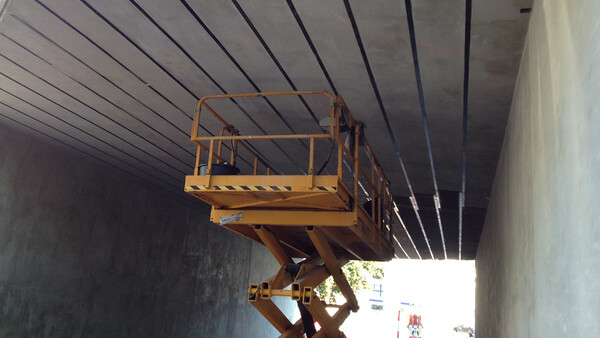Reinforcement of a damaged tension truss
During the construction of a new logistics hall, holes were drilled into a tensioning truss during assembly work. However, the holes hit two tensioning strands in the bottom layer and damaged them. Due to the failure of the two strands, the tensioning truss no longer had sufficient load-bearing capacity. Externally bonded CFRP laminates were selected for reinforcement.
On this page
- Topic
- Reinforcement of a damaged tension truss
- Object
- Logistics centre
- Country
- Germany
- Date
System
Project Description
Solution
The design of the bending tensile reinforcement with CFRP laminates was possible here without any problems. With the S&P FRP Lamella design programme, all verifiable verifications could be carried out quickly and easily. FRP Lamella was also used to support the verifications in the event of fire. With the help of another computer programme, the temperature in the area of the remaining prestressing strands was determined for the fire case and the fire protection requirement R90.
The reduction factor kp(Ɵ) was determined graphically in accordance with EC2 Part 1-2. The reduced strength of the prestressing steel was used in the S&P FRP Lamella design programme and the sufficient load-bearing capacity without reinforcement could be verified for the case of fire. Additional fire protection measures were therefore not required and the CFRP reinforcement may fail as planned in the event of a fire.
Customised steel construction
The real difficulty here lay in the shape and installation or design of the external shear stirrups. Due to the truss analogy, external shear stirrups, usually steel straps, are usually required for components with a calculated shear reinforcement, even with CFRP reinforcements. Due to the double-T shape of the truss, a special design had to be developed here and the space between the web and the lower flange had to be lined.
Fixing with two threaded rods
Unfolding along the contour of the truss leads to delamination of the steel straps in the concave bend under tensile stress. For this purpose, the steel straps were connected to the flange and the web with a welded-on hollow tube (see sketch and Figures 2 and 3). The external shear brackets must be anchored in the compression zone. This is located in the upper area of the web.
They are anchored using a threaded rod, which is loaded to shear in order to absorb the tensile force of the stirrup legs. A second threaded rod was mounted in the centre of the bar so that the hollow tube did not have to be guided to the upper edge of the bar. This creates a pivot point at the lower edge of the hollow tube when the steel straps are subjected to tensile stress, allowing the tensile force of the lower threaded rod to be measured (see sketch).
Space-saving and fast solution
A small drill hole in a tensioning truss can mean major damage. Reinforcement with CFRP laminates was a quick and space-saving solution here, despite the more complex design of the shear stirrups. With the help of the S&P FRP Lamella design programme, it was also possible to carry out a fire design for the prestressed component. The design showed that the CFRP reinforcement does not require any separate fire protection and that the existing component has sufficient load-bearing capacity in the event of fire despite damage.





